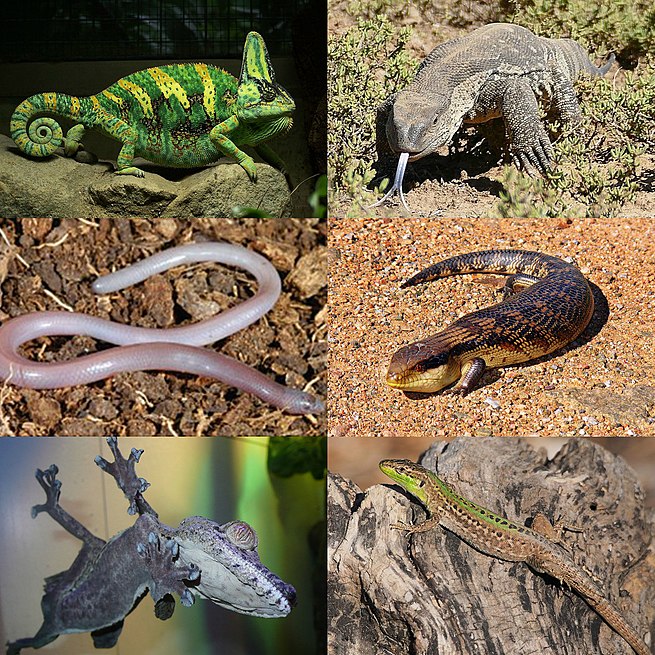
Main Difference
The main difference between Lizard and Salamander is that the Lizard is a suborder of reptiles and Salamander is a order of amphibians
-
Lizard
Lizards are a widespread group of squamate reptiles, with over 6,000 species, ranging across all continents except Antarctica, as well as most oceanic island chains. The group is paraphyletic as it excludes the snakes and Amphisbaenia which are also squamates. Lizards range in size from chameleons and geckos a few centimeters long to the 3 meter long Komodo dragon.
Most lizards are quadrupedal, running with a strong side-to-side motion. Others are legless, and have long snake-like bodies. Some such as the forest-dwelling Draco lizards are able to glide. They are often territorial, the males fighting off other males and signalling, often with brightly colours, to attract mates and to intimidate rivals. Lizards are mainly carnivorous, often being sit-and-wait predators; many smaller species eat insects, while the Komodo eats mammals as big as water buffalo.
Lizards make use of a variety of antipredator adaptations, including venom, camouflage, reflex bleeding, and the ability to sacrifice and regrow their tails.
-
Salamander
Salamanders are a group of amphibians typically characterized by a lizard-like appearance, with slender bodies, blunt snouts, short limbs projecting at right angles to the body, and the presence of a tail in both larvae and adults. All present-day salamander families are grouped together under the order Urodela. Salamander diversity is highest in the Northern Hemisphere and most species are found in the Holarctic ecozone, with some species present in the Neotropical zone.
Salamanders rarely have more than four toes on their front legs and five on their rear legs, but some species have fewer digits and others lack hind limbs. Their permeable skin usually makes them reliant on habitats in or near water or other cool, damp places. Some salamander species are fully aquatic throughout their lives, some take to the water intermittently, and others are entirely terrestrial as adults. They are capable of regenerating lost limbs, as well as other damaged parts of their bodies. Researchers hope to reverse engineer the remarkable regenerative processes for potential human medical applications, such as brain and spinal cord injury treatment or preventing harmful scarring during heart surgery recovery. Members of the family Salamandridae are mostly known as newts and lack the costal grooves along the sides of their bodies typical of other groups. The skin of some species contains the powerful poison tetrodotoxin; these salamanders tend to be slow-moving and have bright warning coloration to advertise their toxicity. Salamanders typically lay eggs in water and have aquatic larvae, but great variation occurs in their lifecycles. Some species in harsh environments reproduce while still in the larval state.
-
Lizard (noun)
Any reptile of the order Squamata that is not a snake, usually having four legs, external ear openings, movable eyelids and a long slender body and tail.
-
Lizard (noun)
Lizard skin, the skin of these reptiles.
-
Lizard (noun)
An unctuous person.
-
Lizard (noun)
A coward.
-
Lizard (noun)
A hand forming a “D” shape with the tips of the thumb and index finger touching (a handshape resembling a lizard), that beats paper and Spock and loses to rock and scissors in rock-paper-scissors-lizard-Spock.
-
Lizard (noun)
A person who idly spends time in a specified place, especially a promiscuous female.
“lounge lizard; lot lizard; beach lizard; truck stop lizard”
-
Salamander (noun)
A long, slender, chiefly terrestrial amphibian of the order Caudata, superficially resembling a lizard.
-
Salamander (noun)
A creature much like a lizard that is resistant to and lives in fire, hence the elemental being of fire.
-
Salamander (noun)
A heraldic representation of the mythological creature, typically accompanied by flames.
-
Salamander (noun)
A metal utensil with a flat head which is heated and put over a dish to brown the top.
-
Salamander (noun)
A small broiler (North America) or grill (Britain), used in professional cookery primarily for browning.
“The chef first put the steak under the salamander to sear the outside.”
-
Salamander (noun)
The pouched gopher, noshow=1, of the southern United States.
-
Salamander (noun)
A large poker.
-
Salamander (noun)
Solidified material in a furnace hearth.
-
Salamander (verb)
To use a salamander (cooking utensil) in a cooking process.
